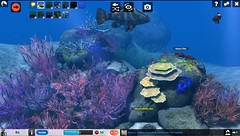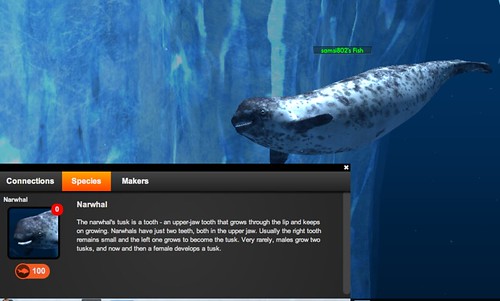For awhile now I have been toying around with "TheBlu," a virtual ocean environment. The creators describe "TheBlu" as "the world's first social digital ocean you can download, explore and share." Essentially it's an interactive screensaver composed of different ocean environments that is populated by marine life created by digital artists from around the world.
 As a digital art experience, TheBlu is quite beautiful and mermerizing. The versimillitude of the ocean, animal and plant life interacting is very well done, particularly for freeware that runs on most decent computer systems. The quiet music, gentle audio cues, and swaying camera combine to make TheBlu a calming and meditative experience.
As a digital art experience, TheBlu is quite beautiful and mermerizing. The versimillitude of the ocean, animal and plant life interacting is very well done, particularly for freeware that runs on most decent computer systems. The quiet music, gentle audio cues, and swaying camera combine to make TheBlu a calming and meditative experience.
That said, there isn't much to do in TheBlu. As a veteran of virtual worlds and digital games, I want to explore all of the lush ocean environments like a scuba diver. Instead you are limited to changing camera views and clicking on the different marine animals you encounter. I guess that wasn't the kind of interaction the makers of TheBlu wanted to support in their virtual environment, but it bothers me every time.

Beyond the artistic merits, TheBlu also seeks to support ocean preservation and protection. Some of their profits go to different ocean protection organizations. In particular, 25% of the proceeds made from purchasing particular species of digital marine life are donated to non-profit organizations helping the ocean. No word on how much has been raised, but that's an interesting nonprofit support model.
Their current nonprofit collaborators are:
To a lesser extent, TheBlu seeks to be an educational experience for the viewer, showing the vast diversity of the ocean and complex interactions among the different species. The most scientific information you can find in TheBlu currently are short blurbs about the marine animals that you click on. Here for example is what it says about the narwhal.
The narwhal's tusk is a tooth — an upper-jaw tooth that grows through the lip and keeps on growing. Narwhals have just two teeth, both in the upper jaw. Usually the right tooth remains small and the left one grows to bcome the tusk. Very rarely, males grow two tusks, and now and then a female develops a tusk.
Not super edifying, but interesting.
There are no citations, links to longer articles, videos, or other resources. Perhaps that would break the immersiveness of the experience, but I found it thin and of questionable merit. Here are two others forclownfish and salmon shark.
TheBlu is still in Beta, and perhaps to be seen if this is going to "light up a million screens" as they hope. In the future, they plan to launch two new versions of TheBlu:
- OpenBlu, to give artists more freedom of expression to create imaginative and fictional species and habitats.
- TrueBlu, a research-based interactive ocean for educational and scientific purposes.
I guess we'll have to wait for TrueBlu to see if the potential for this kind of ocean simulation for education can be realized.
While flawed, TheBlu is definitely an interesting new form of media. I do often spend much longer exploring TheBlu than I plan to, so as immersive and engaging media, it works quite well. I look forward to seeing how it evolves and grows.
